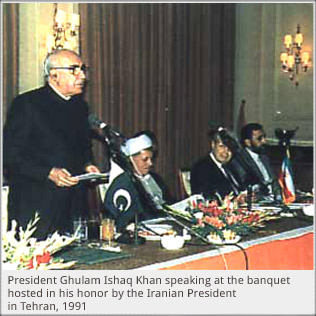In 1988, President Zia-ul-Haq dissolved the Junejo Government and announced that fresh elections would be held in November 1988. But on August 17, 1988, he was killed in a C-130 plane crash in Bhawalpur, along with five senior Generals and the American Ambassador. The cause of the crash has never been ascertained and still remains a riddle.
After the death of General Zia, Ghulam Ishaq Khan, Chairman of the Senate, took over as acting President. Elections for the National and Provincial Assemblies were held on November 16 and 19, 1988, respectively. The Revival of the Constitutional Order had amended the Constitution, which empowered the President to appoint, at his discretion, any member of the National Assembly as Prime Minister. Ghulam Ishaq Khan appointed Benazir Bhutto as Prime Minister of Pakistan on the condition that she would offer full support to him in the forthcoming presidential elections.
According to the deal between Ghulam Ishaq Khan and Benazir Bhutto, Pakistan Peoples Party voted for Ghulam Ishaq Khan. Ghulam Ishaq Khan was also the consensus candidate of Islami Jamuhri Ittehad. Four candidates took part in the elections, with Ghulam Ishaq Khan winning and securing the highest 608 votes. Constitutional Amendments made by the R. C. O. and the Eighth Amendment, that had given the President a great deal of power, inevitably led the President and the Prime Minister into conflict. The conflict between the President and the Prime Minister arose in two areas; the appointment of the Military Chiefs and the Superior Court Judges.
The conflict between the President and the Prime Minister had its drop scene on August 6, 1990, when the President dissolved the National Assembly and Benazir Bhutto was dismissed from power. The dissolution of the National Assembly was soon followed by the dissolution of the Provincial Assemblies. Fresh elections were scheduled on
October 24, 1990. President Ghulam Ishaq Khan appointed Ghulam Mustafa Jatoi as the caretaker Prime Minister.

Differences between Nawaz Sharif and Ghulam Ishaq Khan arose once again. This time they deepened to such an extent that they led to the resignation of both President Ghulam Ishaq Khan and Prime Minister Nawaz Sharif on July 18, 1993. The National and Provincial Assemblies were also dissolved. Moin Qureshi was appointed as the caretaker Prime Minister, and Ghulam Ishaq Khan was appointed the caretaker President. Fresh elections for the National and Provincial Assemblies were held. Benazir Bhutto returned to power for the second time and Farooq Ahmad Khan Leghari was elected as the new President of Pakistan.
This brought to an end the presidency of Ghulam Ishaq Khan, which brought about the dismissal of two elected governments. It followed the unhealthy tradition of removing elected governments through the use of the controversial Eighth Amendment. The next President followed the same tradition and created continuous instability in the country.
This article was last updated on Sunday, June 01, 2003



